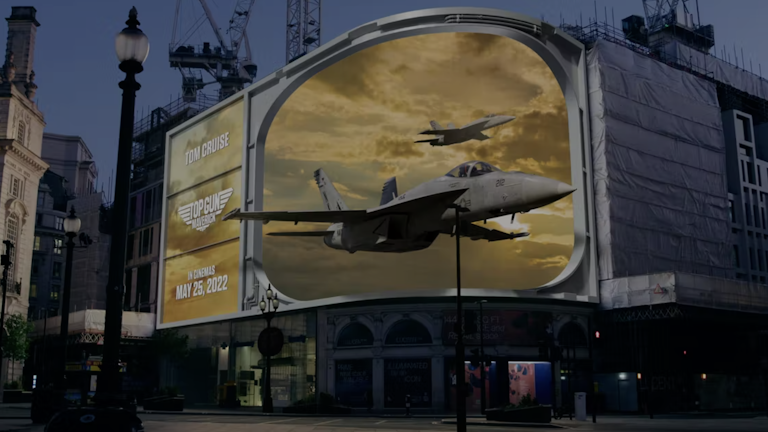Shopping Bag (0)
Your shopping bag is empty


Across media, we're experiencing a wave of retro mania. But how can marketers learn from their colleagues in film, TV and music to capture the yearning hearts of today's nostalgia-obsessives?
As I write this, Kate Bush’s Running Up That Hill is playing. Thanks to Stranger Things S4, it’s currently the second most played song globally on Spotify and Apple Music, becoming her highest chart placement in the US ever, 37 years after the song's original release.
Last night I sat in the cinema grinning at the screen as arguably the world’s last great movie star took to the skies in a love letter to aviation and 80s cinema: Top Gun: Maverick, 36 years after the original hit movie theaters. It was my third viewing in a month; the movie is now close to grossing $1bn globally.
The global success of both Stranger Things and Top Gun: Maverick shows that nostalgia is a potent tool in culture, marketing and entertainment, but only when executed in the right way.
The past is personal. Nostalgia offers us comfort and simplicity at a time of present and future unpredictability. Individuals curate of their own memories and associations, but it’s also a generationally-shared experience.
Nostalgia, when used correctly, can be a positive and joyful tool that instills hope and positivity. But it’s not enough to just evoke those emotions; creators need to use that association and those feelings to drive the story or experience, building a world around the intellectual property and characters.
Top Gun: Maverick's success lies on leaning into all the elements that made the original great, but not pandering to fan service or being a slave to the 1986 material (something that other recent franchises have fallen foul of). The links to the original movie were earned and relevant; not cheap references to seed into trailers. That's part of the reason why it has appealed to a broad audience.
The movie's marketing has taken a similar approach. Teaser posters with simple quotes with Cruise front-and-center; trailers embracing the original’s iconic score; and giant F-18 jets brought to life on the side of buildings through 3D anamorphic OOH.
Conversely, franchises such as Star Wars have had mixed success, with audiences wising up to Disney’s reliance on familiar imagery, childhood memories of favorite characters, and forcing them back into popular worlds without a story to justify it. “Hey, remember this thing you liked?” is not a sustainable strategy to keep audiences coming back. They'll reject it when they realize it’s a tool for hype, rather than an authentic representation of what they know and love.
As a child of the 80s, I’m guilty of over-romanticizing my own childhood, toys, games, movies being at the heart of it. Less the fashion. Over lockdown I found myself playing Streets of Rage II on a console 30 years younger than the game.
My comfort viewing usually consists of Flight of the Navigator, Back to the Future or The Rocketeer. To this day, I lament my collection of Thundercats, Manta Force and GI Joes being offloaded to a distant cousin.
I’ve found comfort in Netflix shows such as The Toys That Made Us, a series of stories behind iconic 80s toy lines. Studies of viewing habits during lockdown indicate I’m not alone, with more than half of streaming audiences diving back into media from their childhoods.
Not treating nostalgia as a gimmick is key. Shows and entertainment that use a period in time for storytelling or character development will always win. Mad Men was not about the 1960s, but it was key to character points of view and situational context.
In 2021 Burger King rebranded for the first time in 20 years. The redesign is a return to a 70s/80s aesthetic, an aesthetic carried through into gen Z fashion, with color, loose fits and graphics returning with a vengeance. This more eco-conscious generation can get their hands on actual retro and vintage clothing by reusing and recycling.
One fascinating nuance of nostalgia is a brand or creator's ability to make an audience nostalgic for a time or period they never actually knew, sometimes known as ‘anemoia’. Quentin Tarantino’s Once Upon a Time in Hollywood was a love letter to a time he experienced, but audiences shared in his nostalgia despite never living it. Retro-futurism is a similar sensation with popular games like Fallout creating a world that seems to live simultaneously in the past and the future.
Triggering emotion through senses, entertainment and experiences continue to be powerful effects of nostalgia. As we all move together into an uncertain future, audiences will continue to seek comfort in what was, whether or not they lived it themselves.
Some may see nostalgia soon running its course. But time never stops moving forward, and we will always seek solace in what we know. So as long as there are childhood memories and culture connected to those memories, then there is inspiration and a wealth of nostalgia to tap into and world-build for generations to come.
Alex Wilson is executive creative director at Amplify.